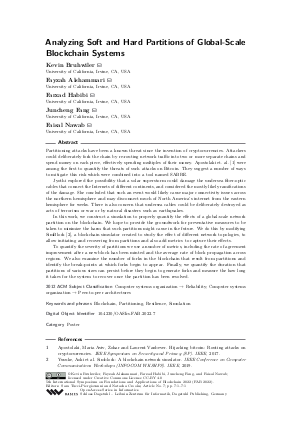Analyzing Soft and Hard Partitions of Global-Scale Blockchain Systems (Poster)
Authors Kevin Bruhwiler, Fayzah Alshammari, Farzad Habibi, Juncheng Fang, Faisal Nawab
-
Part of:
Volume:
5th International Symposium on Foundations and Applications of Blockchain 2022 (FAB 2022)
Part of: Series: Open Access Series in Informatics (OASIcs)
Part of: Conference: International Symposium on Foundations and Applications of Blockchain (FAB) - License:
 Creative Commons Attribution 4.0 International license
Creative Commons Attribution 4.0 International license
- Publication Date: 2022-06-21
File

PDF
OASIcs.FAB.2022.7.pdf
- Filesize: 219 kB
- 1 pages
Document Identifiers
Subject Classification
ACM Subject Classification
- Computer systems organization → Reliability
- Computer systems organization → Peer-to-peer architectures
Keywords
- Blockchain
- Partitioning
- Resilience
- Simulation
Metrics
- Access Statistics
-
Total Accesses (updated on a weekly basis)
0Document
0Metadata
Abstract
Partitioning attacks have been a known threat since the invention of cryptocurrencies. Attackers could deliberately fork the chain by re-routing network traffic into two or more separate chains and spend money on each piece, effectively spending multiples of their money. Apostolaki et. al. [{Apostolaki and {Laurent Vanbever}, 2017] were among the first to quantify the threats of such attacks on Bitcoin. They suggest a number of ways to mitigate this risk which were combined into a tool named SABRE.
Jyothi explored the possibility that a solar superstorm could damage the undersea fiber-optic cables that connect the Internets of different continents, and considered the mostly likely ramifications of the damage. She concluded that such an event would likely cause major connectivity issues across the northern hemisphere and may disconnect much of North America’s internet from the eastern hemisphere for weeks. There is also concern that undersea cables could be deliberately destroyed as acts of terrorism or war or by natural disasters such as earthquakes.
In this work, we construct a simulation to properly quantify the effects of a global-scale network partition on the blockchain. We hope to provide the groundwork for preventative measures to be taken to minimize the harm that such partitions might cause in the future. We do this by modifying SimBlock [{Yusuke, 2019], a blockchain simulator created to study the effect of different network topologies, to allow initiating and recovering from partitions and also add metrics to capture their effects.
To quantify the severity of partitions we use a number of metrics, including the rate of agreement improvement after a new block has been minted and the average rate of block propagation across regions. We also examine the number of forks in the blockchain that result from partitions and identify the break-points at which forks begin to appear. Finally, we quantify the duration that partitions of various sizes can persist before they begin to generate forks and measure the how long it takes for the system to recover once the partition has been resolved.
Cite As Get BibTex
Kevin Bruhwiler, Fayzah Alshammari, Farzad Habibi, Juncheng Fang, and Faisal Nawab. Analyzing Soft and Hard Partitions of Global-Scale Blockchain Systems (Poster). In 5th International Symposium on Foundations and Applications of Blockchain 2022 (FAB 2022). Open Access Series in Informatics (OASIcs), Volume 101, p. 7:1, Schloss Dagstuhl – Leibniz-Zentrum für Informatik (2022)
https://doi.org/10.4230/OASIcs.FAB.2022.7
BibTex
@InProceedings{bruhwiler_et_al:OASIcs.FAB.2022.7,
author = {Bruhwiler, Kevin and Alshammari, Fayzah and Habibi, Farzad and Fang, Juncheng and Nawab, Faisal},
title = {{Analyzing Soft and Hard Partitions of Global-Scale Blockchain Systems}},
booktitle = {5th International Symposium on Foundations and Applications of Blockchain 2022 (FAB 2022)},
pages = {7:1--7:1},
series = {Open Access Series in Informatics (OASIcs)},
ISBN = {978-3-95977-248-8},
ISSN = {2190-6807},
year = {2022},
volume = {101},
editor = {Tucci-Piergiovanni, Sara and Crooks, Natacha},
publisher = {Schloss Dagstuhl -- Leibniz-Zentrum f{\"u}r Informatik},
address = {Dagstuhl, Germany},
URL = {https://drops.dagstuhl.de/entities/document/10.4230/OASIcs.FAB.2022.7},
URN = {urn:nbn:de:0030-drops-162741},
doi = {10.4230/OASIcs.FAB.2022.7},
annote = {Keywords: Blockchain, Partitioning, Resilience, Simulation}
}
Author Details
References
-
Apostolaki, Maria Aviv, Zohar and Laurent Vanbever. Hijacking bitcoin: Routing attacks on cryptocurrencies. IEEE Symposium on Security and Privacy (SP). IEEE, 2017.

-
Yusuke, Aoki et al. Simblock: A blockchain network simulator. IEEE Conference on Computer Communications Workshops (INFOCOM WKSHPS). IEEE, 2019.

